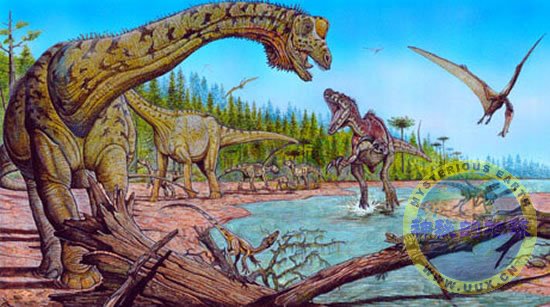阿根廷出土巨型恐龙
Giant Dinosaur Unearthed in Argentina
An artist's rendering depicts a newly discovered giant dinosaur (left and second from left) lumbering through its habitat some 80 million years ago.
Scientists recently unearthed fossils of the 105-foot (34-meter) behemoth along with a trove of other ancient animals in the Patagonia region of Argentina, scientists announced earlier this week.
The third largest dinosaur fossil ever found has been unearthed in the Patagonia region of Argentina by a team of Brazilian and Argentine paleontologists.
The fossil likely represents a new dinosaur species dating back 90 million years, and it is among the most complete ever found of a large dino, the scientists said.
Whereas scientists usually find only 10 percent of a dinosaur's skeleton, the newfound specimen is 70 percent complete.
The giant herbivore measured 105 to 111 feet (32 to 34 meters) long, stood as tall as a four-story building, and weighed 60 to 70 tons.
Researchers named the dinosaur Futalognkosaurus dukei, the first name meaning "giant chief of the dinosaurs" in the Mapuche language, and the second being a nod to the Duke Energy Corporation, a sponsor of the excavation.
While researchers exult in the dino discovery, the site's greatest find lies in its diverse mix of fossils unearthed with the giant dinosaur, said Alexander Kellner of Brazil's National Museum.
"What's most exciting is to have all these fossils in one spot," Kellner said. "It allows us to reconstruct an ecosytem from the Upper Cretaceous period [from 66 million to 100 million years ago]."
The site has a lot more to offer, he added. The team has found another dinosaur, probably also a Futalognkosaurus, even larger than the one unveiled this week.
"It's not close to complete," Kellner said. "It was found scattered and decomposed before being buried. We still have our homework to do there."
The research was led by Jorge Calvo, director of the Paleontology Center of Argentina's Comahue National University.
Dino Could Be "Largest Ever"
The restricted size of the Patagonian site—about 4,300 square feet (400 square meters)—includes mollusks, leaves, fish, crocodile-like reptiles called crocodylomorphs, and other dinosaurs such as a flying pterosaur and a megaraptor whose claws reached 16 inches (40 centimeters).
Thanks to the unusually high number of intact bones found together, scientists can more accurately calculate not only the size of Futalognkosaurus but that of its rivals as well.
"The next step is to re-estimate the sizes of other large dinosaurs," Kellner said.
As the digging continues, Kellner expects more of Futalognkosaurus, potentially revealing that the giant dinosaur is even bigger than is believed.
"This is possibly the largest animal to walk on land," said Jeff Wilson, a paleontologist at the University of Michigan who reviewed the fossil.
The giant dinosaur may have been able to carry its weight because of its birdlike bones, he pointed out.
"You think the long neck must be heavy, but it isn't because of the hollow, air-filled bones," said Wilson.
"This makes them very difficult to collect, because they're so delicate."
Researchers hypothesize that the huge animal fell into a river basin, which helped preserve it and the other fossils. The dinosaur's carcass might have acted as a barrier against river water, collecting organic materials and allowing the material to be covered in sediment.
"That's why the animals fossilized," Kellner, of Brazil's National Museum, said.













